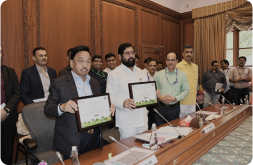










Project Target
0% Remaining
30,000
Trees Planted out of 30,000 Trees

Project Location:
Plantation of local tree species on the Panchayat-owned lands near the water embankments of Surav village, Raigad district, Maharashtra, India.
Project Aim
Situated amidst various water bodies, Raigad district is still prone to seasonal water scarcity and water-borne diseases. According to a report by the Ministry of Water Resources and the Central Ground Water Board, there is a rapid decline in water level during the post-monsoon period, whereas the area goes practically dry during peak summers. The physiography and geology of an area play a major role in the groundwater resource availability and sustainability, which in Raigad district lack behind and indicate the need for further development.
As per Census 2011, around 11.6% of the total population of Mangaon Taluka lives in urban areas while 88.4% lives in rural areas. An article published by India Fellow - An Introduction To Katkari Tribes Of Maharashtra, mentions that “The Katkaris are one of the most marginalized communities of India, being designated as ‘Particularly Vulnerable Tribal Groups (PVTGs)’ within the Scheduled Tribes. Spread in pockets in Gujarat and Maharashtra, a substantial population is spread across all of Raigad district. With a lot of empowerment and rights-based interventions based around the Forest Rights Act, 2006, they have been given some patches of land by the authorities.” Discussing about their living conditions, the article also highlights that, “Post the agricultural season, commencing right after Diwali, able-bodied Katkaris would migrate to work as daily wage labourers in brick kilns or construction sites, only to return at Holi (March). Education is another challenge and migration is one of the main reasons for the same. Every year when the tribal families migrate, the education of their children gets affected as they drop out. They grow up uneducated and end up with the same vocations as their forefathers and this has turned into a vicious cycle over the years.”
The district has limited forest cover, with salt pans developed in certain regions along the coast. A salt pan forms in climates where the rate of water evaporation exceeds the rate of precipitation. They can be dangerous and have the capability to conceal a quagmire of mud that can engulf a truck.
Explaining the phenomenon of how vegetation allows the water to be retained, Dr. Ramachandra says: “Recharging groundwater requires 30-40 percent of open space with vegetation. The vegetation makes soil pervious and helps in percolation.” Furthermore, research led by Associate Professor Ulrik Ilstedt from the Swedish University of Agricultural Sciences (SLU) finds that “moderate tree cover can increase groundwater recharge, and that tree planting and various tree management options can improve groundwater resources. Forests have often been described as ‘sponges’ storing rainwater and slowly releasing it to maintain groundwater and streams during dry periods.” Groundwater flow is one of the mechanisms through which trees keep rivers flowing even during the dry season. In 2011, almost 30% of India’s districts had a groundwater situation that was either semi-critical, critical or overexploited. Studies suggest that if reforesting is done in 20-35% of the river’s catchment, a 10-15% reduction can be seen in flood peak heights after 25 years of forest growth.
The vibrant flora of this district includes species such as Mango (Mangifera indica), Chandan (Santalum album), Khair (Acacia catechu), Banyan tree (Ficus benghalensis) and Teak tree (Tectona grandis) among various others.
Due to the coastline of about 240 kms, Raigad is one of the most important maritime districts of Maharashtra state. A large number of species of fish are found in the Arabian Sea and creeks such as Silver Pomfret (Stromateus argenteus), Sea Bass (Lates calcorifer), Gold Spotted Anchovy (Coilia dussumieri), Mackrel (Rastrelliger Kanagurta), Bombay Duck (Harpadon nehereus), etc. Raigad was also home to the tiger (Panthera tigris), Wild cat (Felies chaus) and Bear (Ursidae carnivora) only a few years ago. These can hardly be spotted these days.
Karanj (Millettia pinnata), Cashew (Anacardium occidentale), Sheesham (Dalbergia sissoo), Earleaf Acacia (Acacia auriculiformis), Jamun (Syzygium cumini), Custard Apple (Annona squamosa) And Lemon (Citrus limon).
On average, a tree offsets 20 kg of carbon and produces 118 kg of oxygen every year upon maturity. The trees reverse the effect of adverse climatic conditions and natural phenomena, thus protecting the community at risk. In addition to augmenting water catchment, reducing soil erosion, recharging groundwater, providing flowers, fruits, fodder and fuel, improving wildlife habitats, generating oxygen, reducing carbon dioxide in the atmosphere and fighting climate change, this project will create approximately 2,455 workdays in the nursery and planting activities alone. By planting these trees, the organization will contribute to protecting soil erosion/Riverbank erosion/Reduce siltation and hence, better-quality water to over 3 million people.
Social Impact of Growing Trees
Community Engagement
Tree planting initiatives often involve local communities, which can lead to greater community cohesion.
Ecological Education
Provides opportunities for community members, especially children, about the importance of environmental sustainability.
Urban Beautification
Trees contribute to the aesthetic enhancement of urban areas, making cities more pleasant and liveable.
Climate Resilience
By improving green cover, tree planting helps make communities more resilient against climate impacts like heatwaves.
Employment Creation
Planting trees creates employment for local community members like planting and maintenance, administrative roles, and more long-term jobs in management.
Wildlife Habitat
Trees provide critical habitats for various species of wildlife. Enhancing tree cover helps preserve biodiversity, which can be an ecological boon for local communities
Copyrights @ 2025 All rights reserved by Pangea EcoNetAssets Pvt Ltd.